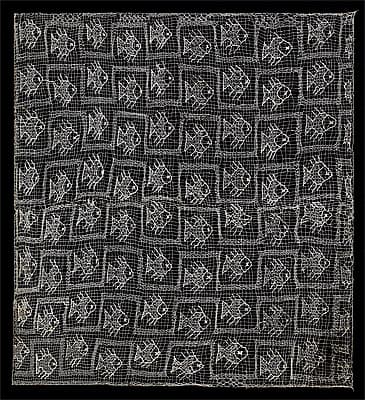
CHANCAY culture Central coast 1200 – 1450 AD
Open-work textile with fish design 1200-1450 AD cotton105.0 (h) x 96.0 (w) cm Fundación Museo Amano, Lima Photograph: Daniel Giannoni
The influence of fishing is evident in open-work fabric. As a coastal culture, the Chancay survived on both ocean and river valley fishing. Net-making developed into superb open-weave cotton textiles with intricate patterns. Weavers initially used cotton—wild and later domesticated—and were adept at controlling density and texture of the complex fabric. Chancay open weave textiles—usually natural fibre rather than dyed—were worn by women as headcloths.
The influence of fishing is evident in open-work fabric. As a coastal culture, the Chancay survived on both ocean and river valley fishing. Net-making developed into superb open-weave cotton textiles with intricate patterns. Weavers initially used cotton—wild and later domesticated—and were adept at controlling density and texture of the complex fabric. Chancay open weave textiles—usually natural fibre rather than dyed—were worn by women as headcloths.
The influence of fishing is evident in open-work fabric. As a coastal culture, the Chancay survived on both ocean and river valley fishing. Net-making developed into superb open-weave cotton textiles with intricate patterns. Weavers initially used cotton—wild and later domesticated—and were adept at controlling density and texture of the complex fabric. Chancay open weave textiles—usually natural fibre rather than dyed—were worn by women as headcloths.

